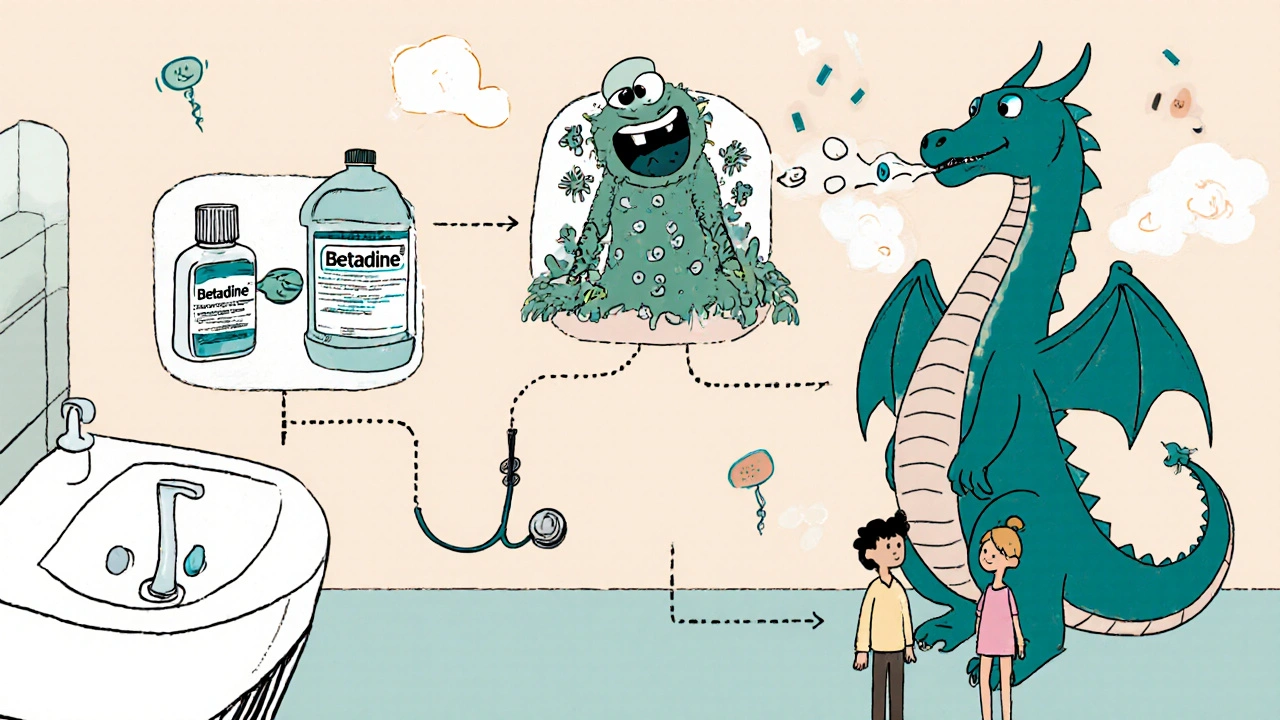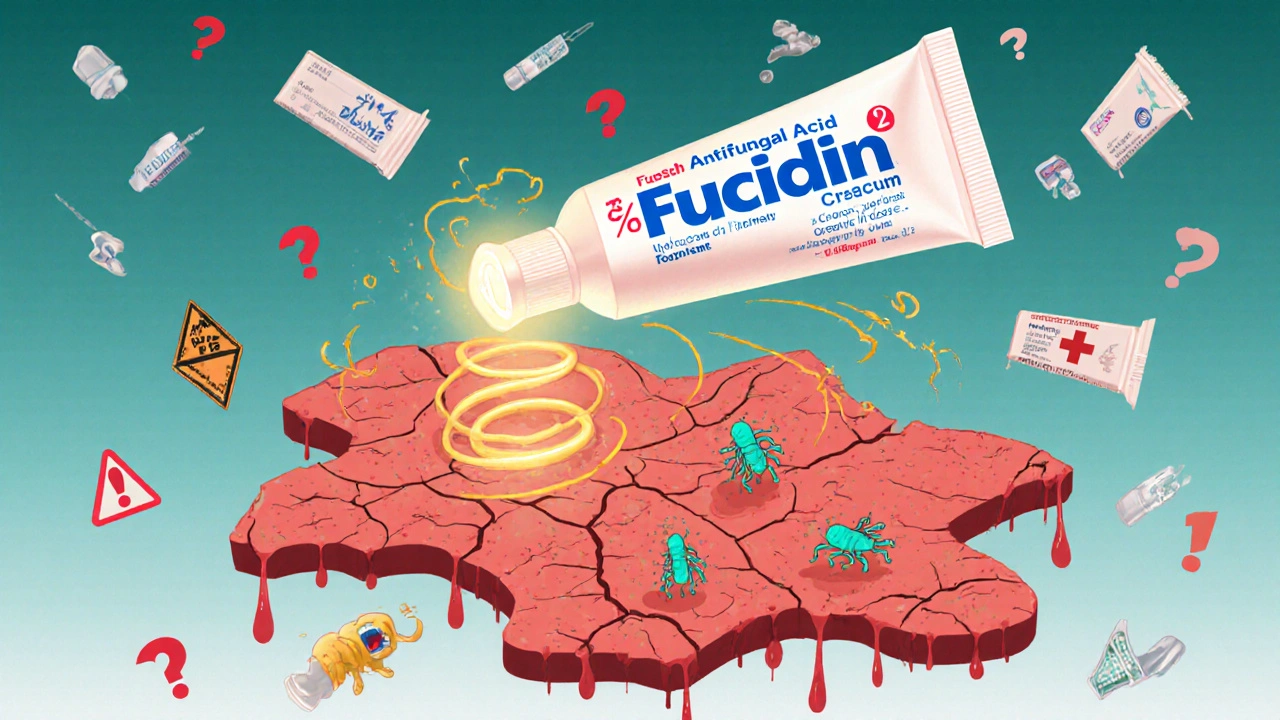When your skin breaks out in red, sore, oozing patches, you don’t need a PhD to know it’s infected. Staph bacteria are the usual culprits, and Fucidin Cream - with its active ingredient fusidic acid - has been a go-to for decades. But is it still the best option? With new alternatives popping up and older ones getting cheaper, it’s worth asking: Fucidin Cream or something else?
What Fucidin Cream Actually Does
Fucidin Cream contains fusidic acid, a narrow-spectrum antibiotic that blocks protein production in bacteria like Staphylococcus aureus - the main bug behind impetigo, infected eczema, and small cuts that turn red and swollen. It doesn’t kill every germ, but it’s highly effective against the ones that commonly infect skin.
It’s not a steroid. It’s not an antifungal. It’s purely antibacterial. That means if your rash is caused by a fungus or a virus, Fucidin won’t help. And if you’ve used it before without improvement, you might be dealing with something else - or the bacteria might be resistant.
It comes in a 2% cream or ointment. You apply it two to three times a day for 7 to 10 days. It’s generally gentle on skin, even for kids and sensitive areas like the face. But resistance is growing. In some regions, up to 15% of staph strains don’t respond to fusidic acid anymore. That’s why doctors are starting to look elsewhere.
Mupirocin (Bactroban): The Closest Competitor
If you’ve ever had a nasal swab for MRSA, you’ve probably used mupirocin. It’s sold as Bactroban cream or ointment and is often the top alternative to Fucidin.
Both target staph. Both are topical. Both are safe for kids. But here’s the difference: mupirocin works differently. It binds to a bacterial enzyme fusidic acid can’t touch. That means if fusidic acid fails, mupirocin might still work - and vice versa.
Studies from the UK and Australia show mupirocin clears impetigo slightly faster than fusidic acid in resistant cases. It’s also more effective against MRSA. But it’s pricier. A 20g tube of Bactroban can cost twice as much as Fucidin. It also needs to be applied three times a day, and some people report mild burning.
Bottom line: If you’re treating a stubborn infection, especially one that didn’t respond to Fucidin, mupirocin is your next best bet.
Retapamulin (Altabax): The New Kid on the Block
Retapamulin is newer. Approved in Australia in 2018, it’s sold as Altabax cream. It’s a pleuromutilin antibiotic - a completely different class than fusidic acid or mupirocin.
It’s approved for impetigo in patients over 9 months old. Clinical trials show it clears up infections in about 85% of cases within 5 days - faster than fusidic acid in some studies. Resistance is still very low because it’s been used less.
It’s more expensive than both Fucidin and Bactroban, and it’s not always covered by the PBS (Pharmaceutical Benefits Scheme). But if you’ve tried two antibiotics already and nothing worked, retapamulin is worth asking your doctor about. It’s not a first-line choice, but it’s a strong backup.
Topical Antiseptics: When Antibiotics Aren’t Needed
Not every red patch needs an antibiotic. Sometimes, a simple antiseptic does the job - and avoids the risk of resistance.
Chlorhexidine (Hibiclens) and povidone-iodine (Betadine) are both effective at killing surface bacteria. They’re great for cleaning minor cuts, scrapes, or weeping eczema before applying a moisturizer. In mild cases, especially in kids, cleaning twice a day with diluted Betadine and keeping the area covered with a light dressing can clear up infection without any antibiotic.
A 2023 study in Melbourne’s pediatric clinics found that for mild impetigo, antiseptic cleaning alone worked as well as fusidic acid in 70% of cases - and had zero risk of resistance.
Use these if your infection is small, not spreading, and doesn’t have pus or crusting. If it’s getting worse after 3 days, switch to an antibiotic.

Oral Antibiotics: When Cream Isn’t Enough
Topical treatments only go so far. If the infection is large, spreading quickly, or you have a fever, you need an oral antibiotic.
Dicloxacillin and cephalexin are the most common. They work from the inside out and are more effective than creams when the bacteria have gotten deeper into the skin.
Some doctors will start with a cream and add an oral if there’s no improvement in 48 hours. Others jump straight to oral if the infection covers more than a few centimeters or if the patient is under 2 years old.
Don’t skip this step if your infection is worsening. A small patch can turn into cellulitis - a serious deeper skin infection - in less than 24 hours.
What Not to Use
Don’t use over-the-counter antifungal creams like clotrimazole or terbinafine unless you’re sure it’s a fungal infection. Most staph infections look like fungal ones - red, itchy, flaky. But antifungals won’t touch staph.
Same goes for hydrocortisone cream. It reduces redness and itching, which makes it tempting to use on infected skin. But steroids suppress the immune response. That can let the infection spread faster. Never mix steroid creams with antibiotics unless your doctor specifically says to.
And avoid home remedies like tea tree oil, honey, or garlic paste. While some lab studies show antibacterial effects, there’s no reliable clinical proof they work on human skin infections. Worse, they can irritate skin and delay proper treatment.
Choosing the Right Option
Here’s how to decide:
- First-time, mild infection - Start with Fucidin Cream. It’s affordable, effective, and gentle.
- Didn’t work after 5 days - Switch to mupirocin. It’s the next most reliable option.
- Recurrent or resistant infection - Ask about retapamulin. It’s newer and still highly effective.
- Small, early patch - Try cleaning with Betadine twice daily. Might clear it without antibiotics.
- Spreading, painful, or feverish - See a doctor. You’ll likely need oral antibiotics.
Don’t keep switching creams. Each time you use an antibiotic, you increase the chance of resistance. Stick with one for the full course - even if it looks better after 3 days.

How to Apply Topical Antibiotics Right
Getting the most out of your cream matters as much as which one you pick.
- Wash the area with mild soap and water. Pat dry - don’t rub.
- Apply a thin layer. A pea-sized amount covers a 5cm patch. More doesn’t mean faster healing.
- Don’t cover it with a bandage unless your doctor says to. Air helps healing.
- Wash your hands before and after. You don’t want to spread the infection to other parts of your body or to others.
- Finish the full course. Even if it looks gone, keep applying for the full 7-10 days.
Missed a dose? Apply it as soon as you remember. Don’t double up. Just get back on schedule.
When to See a Doctor
Most skin infections clear up with cream and good hygiene. But call your doctor if:
- The redness spreads beyond the original area
- Pus or yellow crusting gets worse
- You develop a fever
- The infection doesn’t improve after 5 days of treatment
- You have diabetes, a weakened immune system, or eczema
These aren’t emergencies - but they’re signals that you might need something stronger than a cream.
Cost and Availability in Australia
Fucidin Cream is on the PBS. With a prescription, it costs around $7.30 for a 30g tube. Without a script, it’s about $25.
Mupirocin (Bactroban) is not on the PBS. You’ll pay $40-$50 out of pocket.
Retapamulin (Altabax) is also not subsidised. Expect to pay $80-$100. It’s rarely used unless other options fail.
Antiseptics like Betadine are OTC and cost under $10. They’re a smart first step if you’re unsure.
Insurance doesn’t cover OTC antiseptics, but if you’re on a pension or health card, Fucidin is your most affordable option.
Final Take
Fucidin Cream is still a solid first choice for most minor skin infections. It’s cheap, effective, and gentle. But it’s not the only option - and it’s not always the best.
For resistant cases, mupirocin wins. For stubborn infections that won’t quit, retapamulin is the hidden gem. For mild cases, antiseptics can work just as well - and without the risk of resistance.
The real secret? Don’t wait. Start treatment early. Clean the area. Use the right product for your situation. And if it doesn’t improve, don’t guess - see a doctor.
Is Fucidin Cream the same as fusidic acid?
Yes. Fucidin Cream is the brand name for a topical cream that contains fusidic acid as its active ingredient. Fusidic acid is the antibiotic; Fucidin is the product you buy at the pharmacy.
Can I use Fucidin Cream on my face?
Yes, it’s safe for facial use, including around the eyes and mouth. It’s often prescribed for infected eczema on the face in children. Just avoid getting it in your eyes. Wash your hands after applying.
How long does it take for Fucidin Cream to work?
Most people see improvement within 2-3 days. Redness and oozing should start to reduce. But you need to use it for the full 7-10 days to kill all the bacteria and prevent it from coming back.
Can I use Fucidin Cream with other creams?
Only if your doctor says so. Don’t mix it with steroid creams (like hydrocortisone) unless prescribed. You can apply moisturisers after Fucidin has dried - wait about 15 minutes. Never layer antibiotics on top of each other.
What happens if I stop using Fucidin Cream early?
The infection might seem better, but the strongest bacteria survive and multiply. This leads to recurrence - and antibiotic resistance. You might need a stronger treatment next time, or even oral antibiotics. Always finish the full course.
Is Fucidin Cream safe for babies?
Yes. Fucidin Cream is approved for use in infants over 1 month old. It’s commonly used for impetigo in babies. Apply only to affected areas, and wash your hands thoroughly before and after. If the rash spreads or your baby develops a fever, see a doctor immediately.
If you’ve tried Fucidin and it didn’t work, don’t assume you’re out of options. There are better, sometimes cheaper, and more targeted alternatives - but only if you know when and how to use them.


Comments (11)
Arthur Coles
Fusidic acid is just the pharmaceutical industry's way of locking you into a cycle of dependency while they patent the next 'miracle' cream every 5 years. Did you know the WHO flagged fusidic acid resistance as a 'critical priority' in 2017? But you won't hear that from Big Pharma's ad campaigns. They'd rather you keep buying Bactroban at $50 a tube than admit the system's rigged. 🤡
Kristen Magnes
Hey, I get that resistance is scary, but don't panic. You don't need to be a microbiologist to treat a skin infection. Start simple: clean it, keep it dry, try Betadine first. If it doesn't improve in 3 days, move to Fucidin. Most cases clear up without needing the expensive stuff. You've got this - and you don't need to spend $100 to feel better.
adam hector
Let’s be real - antibiotics are just Band-Aids for a civilization that’s lost touch with its own immune system. We’ve forgotten that skin is a living organ, not a battlefield. The real question isn’t which cream works faster - it’s why we keep treating symptoms instead of healing the terrain. Fucidin? Mupirocin? Retapamulin? All just temporary fixes while our microbiomes collapse under glyphosate, processed food, and chronic stress. The cure isn’t in a tube - it’s in your diet, your sleep, your breath.
Ravi Singhal
bro i had this rash last year and tried fucidin first - nothing. then i used mupirocin and it worked in 3 days. but honestly? i started using dilute betadine every night and it stopped spreading before i even got the cream. dont overthink it. clean it, dont scratch, and if it dont get better in 4 days, see a doc. simple.
Victoria Arnett
I used Fucidin on my kid’s eczema and it worked great but I didn’t know you weren’t supposed to mix it with hydrocortisone until my dermatologist yelled at me. Now I wait 20 minutes after the cream before I put on moisturizer. Also the ointment version doesn’t sting like the cream. Just saying.
HALEY BERGSTROM-BORINS
Why is it that every time we find a solution, Big Pharma makes it unaffordable? 🤔 Fucidin costs $7 with a script but Bactroban? $50? And retapamulin? $100?! That’s not medicine - that’s exploitation. 🤬 And don’t even get me started on how they push new drugs before long-term studies are done. 🤯 We’re lab rats with insurance cards.
Sharon M Delgado
As someone who grew up in rural India, where antibiotics were scarce, we used turmeric paste, neem leaves, and honey - and guess what? Most infections cleared up. Not because it was 'natural' - but because we didn’t overuse chemicals. Now, in the U.S., we treat every pimple like it’s the Black Death. I’m not saying ditch science - but maybe we’ve forgotten humility. A little patience. A little clean water. A little faith in the body’s own healing.
Dr. Marie White
I appreciate how thorough this breakdown is. As a primary care provider, I see too many patients cycling through antibiotics because they stop too early or use the wrong one. The key takeaway - and I say this to every patient - is: Don’t self-diagnose. If it’s spreading, painful, or you’re feverish, it’s not just a rash. It’s a signal. Listen to your body. And if you’re unsure, call your doctor. No shame in that.
Wendy Tharp
Of course Fucidin works - it’s the cheapest thing on the market. But that’s exactly why it’s being pushed. The government wants you to use it so they don’t have to pay for oral antibiotics. Meanwhile, the real solution - better hygiene, less sugar, more sleep - is never mentioned. Why? Because it doesn’t sell. This whole system is designed to keep you sick and buying. You’re not just treating a rash - you’re participating in a scam.
Subham Das
One cannot help but observe the metaphysical implications of our collective obsession with topical pharmacological intervention. The skin, as the largest organ, is not merely a barrier - it is a mirror of our internal dissonance, a canvas upon which our modern alienation is painted in erythematous strokes. To reach for fusidic acid is to surrender to the Cartesian dualism of body and self - as if healing could be reduced to molecular inhibition. The true cure lies not in the tube, but in the reclamation of somatic sovereignty - through fasting, breathwork, and the abandonment of pharmaceutical dependency. Retapamulin? A Band-Aid on a soul wound. The ancients knew: infection is not an enemy - it is a messenger.
Cori Azbill
Let’s be honest - if you’re using any of these creams, you’re already losing. In America, we treat every minor skin issue like it’s a national security threat. In Russia? They just use salt water and a clean rag. In Japan? They use aloe and patience. We’re so addicted to chemical quick fixes that we’ve forgotten how to heal naturally. And now we’re paying $100 for a cream that’s just a repackaged version of something that existed in 1962. This isn’t progress - it’s corporate colonialism wrapped in a prescription.